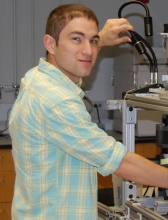
Major:
University:
Mentor(s):
Faculty Sponsor(s):
Faculty Sponsor's Department(s):
Project Title:
Project Description:
The shape of a bonded holdfast is known to contribute to its adhesive strength. For example, the bond strength of a rectangular pillar is an order of magnitude weaker than that of a spatula with the same contact area. A common shape employed by many organisms (e.g. geckos, spiders, mussels) to bond permanently or temporarily to surfaces is the mushroom shape, suggesting this holdfast geometry is an effective way to optimize adhesive performance. The mushroom shape features a cylindrical thread attached to a circular adhesive plaque. It is not known how aspects of the mushroom shape affect adhesion performance, so we created an experimental model system to study detachment of a single mushroom shaped fibril adhered to a flat surface. The model system consists of polydimethylsiloxane cast into mushroom-shapes, with well-defined thread diameter and plaque thickness. Here, plaque diameter is fixed at 6.4mm while thread diameter ranged from 1.6-4.8mm and plaque thickness ranged from .8-6.4mm. Samples were adhered to tape and the thread displaced by a custom load frame that also recorded the tensile forces (the largest of which is our bond strength). A microscope was used to simultaneously image the debonding interface. Preliminary results indicate that bond strength decreases with increasing plaque thickness and thread diameter, and the location of debonding initiation depends on the mushroom shape. Through systematic variation of plaque and thread size, this work will establish a functional relationship between shape parameters, bond strength and the mechanisms of debonding.
